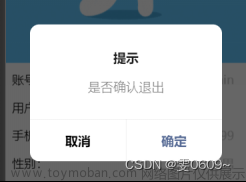目录
01. 为什么进行模块封装
02. 消息提示模块封装
03. 模态对话框封装
04. 封装本地存储 API
05. 拓展:封装异步存储API+优化代码
01. 为什么进行模块封装
在进行项目开发的时候,我们经常的会频繁的使用到一些 API,
例如:wx.showToast() 、wx.showModal()等消息提示 API ,这些 API 的使用方法如下:
wx.showToast({
title: '消息提示框', // 提示的内容
icon: 'success', // 提示图标
duration: 2000, // 提示的延迟时间
mask: true // 是否显示透明蒙层,防止触摸穿透
})
wx.showModal({
title: '提示', // 提示的标题
content: '您确定执行该操作吗?', // 提示的内容
confirmColor: '#f3514f', // 确定按钮的样式
// 接口调用结束的回调函数(调用成功、失败都会执行)
complete({ confirm, cancel }) {
if (confirm) {
console.log('用户点击了确定')
return
}
if (cancel) {
console.log('用户点击了取消')
}
}
})如果每次使用的时候,都直接调用这些 API,会导致代码很冗余,为了减少了代码冗余,我们需要将这些 API 封装成公共方法,封装后的使用方式如下:
// wx.showToast() 封装后的调用方式
toast()
toast({ title: '数据加载失败....', mask: true })
// wx.showModal() 封装后的调用方式
const res = await modal({
title: '提示',
content: '鉴权失败,请重新登录 ?'
})
// 用户点击了确定
if (res) { ... } else { ... }可以看到封装后方法,极大简化 API 的调用,
同时,我们在后续还会进行网络通用模块的封装,如果直接进行封装难度比较大,
进行通过模块的封装,也是为后续 [网络请求封装] 做铺垫。
02. 消息提示模块封装
基本使用:
wx.showToast() 消息提示框是在项目中频繁使用的一个小程序 API,常用来给用户进行消息提示反馈。使用方式如下:
wx.showToast({
title: '消息提示框', // 提示的内容
icon: 'success', // 提示的图标,success(成功)、error(失败)、loading(加载)、none(不显示图标)
duration: 2000, // 提示的延迟时间
mask: true // 是否显示透明蒙层,防止触摸穿透
})封装思路:
-
创建一个
toast方法对wx.showToast()方法进行封装 -
调用该方法时,传递对象作为参数
-
如果没有传递任何参数,设置一个空对象
{}作为默认参数 -
从对象中包含
title、icon、duration、mask参数,并给参数设置默认值
-
-
在需要显示弹出框的时候调用
toast方法,并传入相关的参数,有两种参数方式:- 不传递参数,使用默认参值
- 传入部分参数,覆盖默认的参数
调用方式:
新封装的模块,我们希望有两种调用的方式:
模块化的方式导入使用
import { toast } from './extendApi'
toast()
toast({ title: '数据加载失败....', mask: true })
将封装的模块挂载到 wx 全局对象身上
wx.toast()
wx.toast({ title: '数据加载失败....', mask: true })实现步骤:
- 在
utils目录下新建extendApi.js文件 - 对
wx.showToast()方法进行封装
落地代码:
➡️ utils/extendApi.js
/**
* @description 封装消息提示组件
* @param {*} title 提示的内容
* @param {*} icon 图标
* @param {*} duration 提示的延迟时间
* @param {*} mask 是否显示透明蒙层,防止触摸穿透
*/
const toast = ({ title = '数据加载中', icon = 'none', mask = true, duration = 3000 } = {}) => {
wx.showToast({
title,
icon,
mask,
duration
})
}
// 在 wx 全局对象上封装 toast 方法
// 调用 API 方式:
// 1. 在入口文件 app.js 导入封装的模块 import './utils/extendApi'
// 2. 调用封装的方法:wx.toast('')
wx.toast = toast
// 模块化的方式使用
// 调用 API 方式:
// 1. 导入该文件:import { toast } from '../utils/extendApi'
// 2. 调用封装的方法:toast('')
export { toast }
➡️ app.js
import { toast } from './utils/extendApi'
App({
onLaunch() {
// 第一种调用方式:不传入任何参数
toast()
// 第二种调用方式:传入部分参数
toast({ title: '数据加载失败....', mask: true })
// 第三种调用方式:传入全部的参数
toast({ title: '数据加载失败....', mask: true })
}
})03. 模态对话框封装
基本使用:
wx.showModal() 模态对话框也是在项目中频繁使用的一个小程序 API,通常用于向用户询问是否执行一些操作,例如:询问用户是否真的需要退出、是否确认删除等等
wx.showModal({
title: '提示', // 提示的标题
content: '您确定执行该操作吗?', // 提示的内容
confirmColor: '#f3514f',
// 接口调用结束的回调函数(调用成功、失败都会执行)
complete({ confirm, cancel }) {
confirm && console.log('点击了确定')
cancel && console.log('点击了取消')
}
})封装思路:
- 对
wx.showModal()方法进行封装, 封装后的新方法叫modal - 调用该方法时,传递对象作为参数,对象的参数同
wx.showModal()参数一致 - 封装的
modal方法的内部通过Promise返回用户执行的操作(确定和取消,都通过 resolve 返回) - 在需要显示模态对话框的时候调用
modal方法,并传入相关的参数,有三种调用方式:- 不传递参数,使用默认参数
- 传递参数,覆盖默认的参数
调用方式:
新封装的本地存储模块,我们依然希望有两种调用的方式:
- 模块化的方式导入使用
- 将封装的模块挂载到
wx全局对象身上
实现步骤:
- 在
extendApi.js文件中新建modal方法,方法内部 -
modal方法,方法内部用来处理封装的逻辑
落地代码:
➡️ utils/extendApi.js
// coding...
/**
* @description 封装 wx.showModal 方法
* @param {*} options 同 wx.showModal 配置项
*/
export const modal = (options = {}) => {
// 使用 Promise 处理 wx.showModal 的返回结果
return new Promise((resolve) => {
// 默认的参数
const defaultOpt = {
title: '提示',
content: '您确定执行该操作吗?',
confirmColor: '#f3514f',
}
// 将传入的参数和默认的参数进行合并
const opts = Object.assign({}, defaultOpt, options)
wx.showModal({
// 将合并的参数赋值传递给 showModal 方法
...opts,
complete({ confirm, cancel }) {
// 如果用户点击了确定,通过 resolve 抛出 true
// 如果用户点击了取消,通过 resolve 抛出 false
confirm && resolve(true)
cancel && resolve(false)
}
})
})
}
// 在 wx 全局对象上封装 myToast 方法
// 调用 API 方式:
// 1. 在入口文件 app.js 导入封装的模块 import './utils/extendApi'
// 2. 调用封装的方法:wx.toast('')
wx.toast = toast
+ wx.modal = modal
// 模块化的方式使用
// 调用 API 方式:
// 1. 导入该文件:import { toast } from '../utils/extendApi'
// 2. 调用封装的方法:toast('')
+ export { toast, modal }
➡️ app.js
import { modal } from './utils/extendApi'
App({
async onLaunch() {
// 第一种调用方式:不传入任何参数
// 不使用任何参数,使用默认值
const res = await modal()
console.log(res)
// 第二种调用方式:更改默认配置
const res = await modal({
content: '鉴权失败,请重新登录',
showCancel: false
})
console.log(res)
}
})04. 封装本地存储 API
思路分析:
在小程序中,经常需要将一些数据存储到本地,方便多个页面的读取使用,例如:将用户的登录状态、用户的个人信息存储到本地。
小程序提供了同步、异步两类 API 来实现本地存储操作。例如: wx.setStorageSync、wx.setStorage 等方法
try {
wx.setStorageSync(key, value)
} catch (err) {
console.error(`存储指定 ${key} 数据发生错误:`, err)
}
wx.setStorage({
key: 'key',
data: 'data',
success (res) => {},
fail (err) => {}
})
如果直接使用这些 API,会比较麻烦,通常情况下,我们需要对本地存储的方法进行封装。
实现步骤:
- 在
utils目录下新建storage.js文件 - 在该文件中,封装对本地数据进行 存储、获取、删除、清除的方法
落地代码:
➡️ utils/storage.js文章来源地址https://www.toymoban.com/news/detail-836275.html
/**
* @description 存储数据
* @param {*} key 本地缓存中指定的 key
* @param {*} value 需要缓存的数据
*/
export const setStorage = (key, value) => {
try {
wx.setStorageSync(key, value)
} catch (e) {
console.error(`存储指定 ${key} 数据发生错误:`, e)
}
}
/**
* @description 从本地读取对应 key 的数据
* @param {*} key
*/
export const getStorage = (key) => {
try {
const value = wx.getStorageSync(key)
if (value) {
return value
}
} catch (e) {
console.error(`获取指定 ${key} 数据发生错误:`, e)
}
}
/**
* @description 从本地移除指定 key 数据
* @param {*} key
*/
export const removeStorage = (key) => {
try {
wx.removeStorageSync(key)
} catch (err) {
console.error(`移除指定 ${key} 数据发生错误:`, e)
}
}
/**
* @description 从本地清空全部的数据
*/
export const clearStorage = () => {
try {
wx.clearStorageSync()
} catch (e) {
console.error("清空本地存储时发生错误:", e);
}
}
05. 拓展:封装异步存储API+优化代码
思路分析:
使用 Promise 封装异步存储 API
wx.setStorage({
key: 'key',
data: 'data',
success(res) {},
fail(err) {},
complete(res) {}
})使用方式:
// 异步将数据存储到本地
asyncSetStorage(key, data)
// 异步从本地读取指定 key 的数据
asyncGetStorage(key)
// 异步从本地移除指定 key 的数据
asyncRemoveStorage(key)
// 异步从本地移除、清空全部的数据
asyncClearStorage()落地代码:文章来源:https://www.toymoban.com/news/detail-836275.html
➡️ utils/storage.js
/**
* @description 将数据存储到本地 - 异步方法
* @param {*} key 本地缓存中指定的 key
* @param {*} data 需要缓存的数据
*/
export const asyncSetStorage = (key, data) => {
return new Promise((resolve) => {
wx.setStorage({
key,
data,
complete(res) {
resolve(res)
}
})
})
}
/**
* @description 从本地读取指定 key 的数据 - 异步方法
* @param {*} key
*/
export const asyncGetStorage = (key) => {
return new Promise((resolve) => {
wx.getStorage({
key,
complete(res) {
resolve(res)
}
})
})
}
/**
* @description 从本地移除指定 key 的数据 - 异步方法
* @param {*} key
*/
export const asyncRemoveStorage = (key) => {
return new Promise((resolve) => {
wx.removeStorage({
key,
complete(res) {
resolve(res)
}
})
})
}
/**
* @description 从本地移除、清空全部的数据 - 异步方法
*/
export const asyncClearStorage = () => {
return new Promise((resolve) => {
wx.clearStorage({
complete(res) {
resolve(res)
}
})
})
}
到了这里,关于微信小程序 --- 通用模块封装(showToast,showModal ,本地存储)的文章就介绍完了。如果您还想了解更多内容,请在右上角搜索TOY模板网以前的文章或继续浏览下面的相关文章,希望大家以后多多支持TOY模板网!










